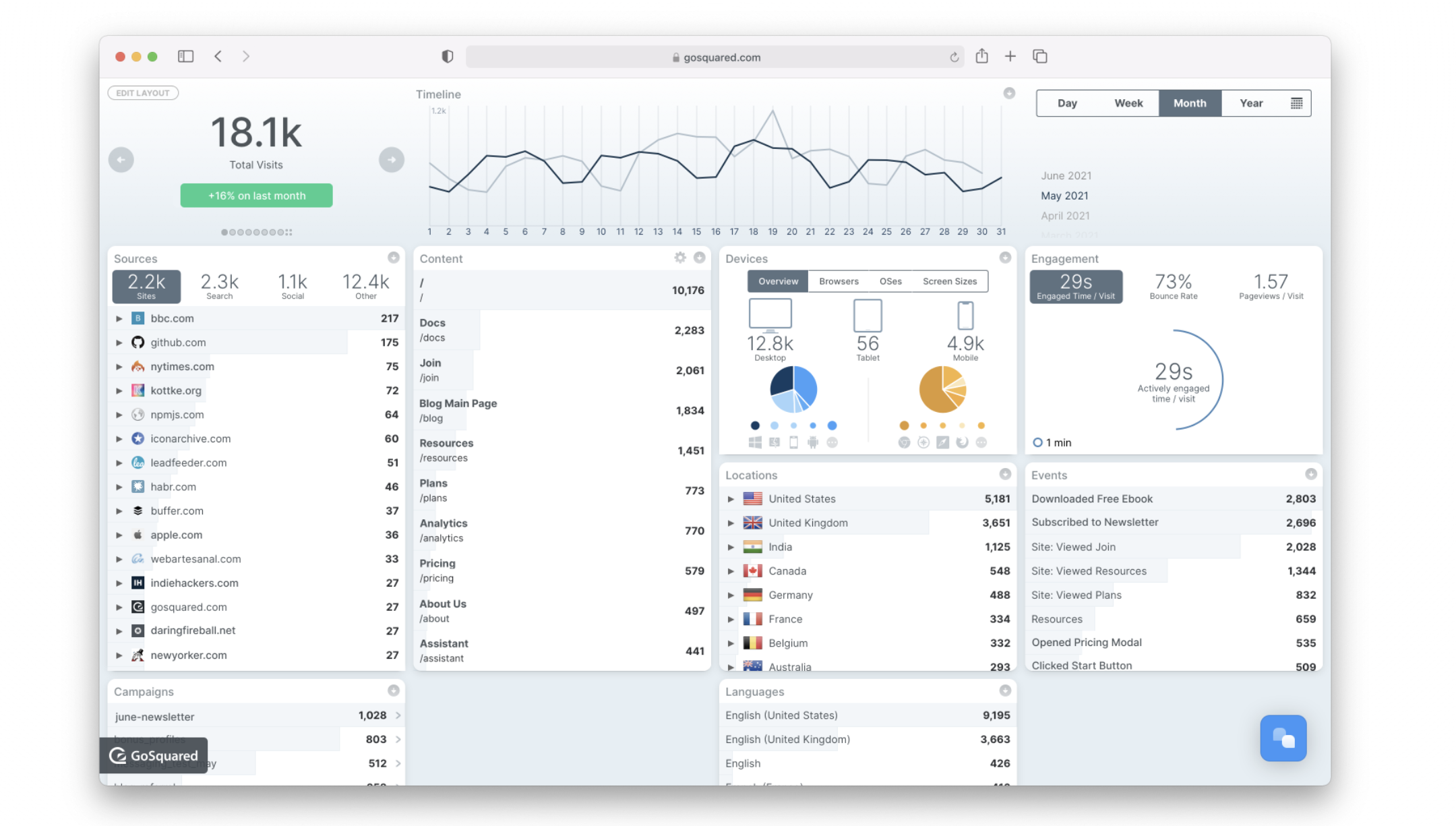Data-driven marketing is a simple way to streamline your marketing efforts.
Whether you’re new to data-driven marketing and need further explanation, or if you’re interested in seeing some examples that could inform your next campaign, you’re in luck. As in today’s post, we will uncover everything you need to know about the practice.
Plus, we’ll explain how GoSquared can help you capture the data you need to be able to perform data-driven marketing so that you can get ahead with your campaigns, and most importantly understand your audience in a whole new light.
Data-Driven Marketing: What Is It?
In essence, data-driven marketing boils down to having more relevant conversations with your audience.
So, that age-old adage of having the ‘right message for the right person at the right time and in the right place’.
While that idea sounds simple enough, actually aligning these four aspects so that conversions are more likely is a tricky feat to achieve.
How Does Data-Driven Marketing Work?
Data-driven marketing encompasses the following aspects that all work in tandem with each other:
- Marketing data
- Marketing team
- Marketing strategy
- Inbound strategy
- Content marketing
- Marketing campaigns
- Marketing tech
Marketing data including analytics is the core pillar of these aspects. In today’s world, there are endless opportunities to gather data about your existing customers and potential leads that are going to help you streamline your marketing efforts.
These can include social media, email, web analytics, and even digital advertising. Every interaction offers an opportunity for you as a business to learn more about your customer’s wants and needs.
Only if a company captures and makes use of this data can a marketing strategy be data-driven. For example, if you own an ecommerce store and see a customer has repeatedly visited a product page but hasn’t bought that product, a data-driven marketing technique would be alerting that customer when the item is on sale. It’s simple yet highly effective.
How Is Data-Driven Marketing Different From Traditional Marketing?
Traditional marketing techniques can include brochures, letters, flyers, billboard advertising, signage, television and word of mouth. While traditional marketing still has its place in many respects, the simple truth is that the techniques are not based on smart data as is the case with data-driven marketing. Although it’s possible to gain some metrics about where to best place a physical advertisement, or even the right age demographic who may be interested in your mailer, traditional marketing is missing a fundamental component: data.
However, when data-driven marketing methods are used, you can not only create marketing campaigns that are more intrinsically informed, but also better understand the impact of the campaign. So for instance with a digital advertisement that may be placed on a website, you can understand how many views, clicks and impressions that advert received.
But with the likes of a flyer or billboard, it’s difficult to gauge the true impact because the same types of data-driven metrics aren’t attached. You can’t be sure how your Times Square advertisement of a fragrance directly impacted sales, nor can you tell if people even interacted with it and for how long – but with any digital assets, the amount of information you can find and then use to your advantage with future campaigns is endless.
P.S: Like the look of what you see above? You too can have your very own website analytics platform that displays powerful real-time data with GoSquared Analytics.
Why Is Data-Driven Marketing Important?
The whole purpose of marketing is to facilitate sales and build brand awareness. So the reason that data-driven marketing is important for that aim, is that the information gained can be used to make better decisions.
Ultimately, data-driven marketing improves processes, increases productivity, defines ideal prospects more easily, and allows marketers to run more efficient campaigns.
Read more: Audience Segmentation – The Beginner’s Guide.
Data-Driven Marketing Examples
Ready to see some fantastic data-driven marketing campaigns in action? We’ve scoured the land to find the best examples that highlight the true value of data-driven marketing.
1. Messaging Strategy Upgrade

Simplero is an all-in-one marketing software for coaches, consultants and course creators. Before doing customer research to create a winning value proposition, they were using confusing messaging, and as the saying goes, ‘confused people don’t buy‘.
As marketing expert Claire Suellentrop elaborates here, a common mistake is using cutesy language that “could mean anything.”
Instead of using their website to clearly call out their target audience of coaches, consultants, and course creators, Simplero was calling them “leaders.”
It’s true, this sort of entrepreneur is a leader and is very focused on creating an impact in the world, but the terms leaders could also refer to c-suite executives as multinational corporations.
Here’s before the customer research process:

Here’s after:

It’s now a whole lot more clear who Simplero serves and what they have to offer.
We’ll get into quantitative data and targeting data in a minute. But first, we thought we’d kick things off with qualitative data.
Why? If you’re not doing customer research, learning from it, and implementing it, then all of these other data-driven marketing examples won’t help you much.
Here are some of the best questions you can ask your customers:
- How did you discover Company Name?
- What made you decide to try / buy from Company Name?
- What were you using before discovering Company or Product Name?
- What did you like or dislike about the product / service you used to use?
- What is your favorite thing about Company Name or Product Name?
- What aspects of Company Name or Product Name could you not live without?
If you’re in development on a new product here are relevant questions to ask to validate the product in advance of its launch.
2. Data-Driven Website Chat

Not every website visitor is equally valuable to your business. That’s a given. But the same goes for website visitors who engage with you via live chat. Not everyone who wants to chat with someone on your team is an ideal customer. You can use data to help you suss out who’s really worth your time.
We’re not saying to ignore anyone who chats with you on your website. But you can use data to learn how to respond to your website visitors.
Whether the person is an existing customer, a frequent website visitor (but not yet a customer), or a first-time visitor can all impact how you respond with them.
Because GoSquared’s Live Chat is built on top of our analytics platform, you can learn who you’re chatting with before you engage. Meeting customers and prospects where they are can power your team to increase conversion rates via chat.
3. Conversion Rate Optimisation

Conversion rate optimization testing is viewed as the holy grail for big upticks in conversions. More realistically though, you’ll see incremental differences as you test things over time.
Here are some things you can test:
- The format of your landing page or signup page (short form versus long form)
- The call-to-action
- The headline
- The photograph
Really, the list goes on and on.

Conversion rate optimization is at its very essence driven by data, but there is one caveat: you will need sufficient traffic to run legitimate tests with tools like Google Optimize. Otherwise, you can a tool like Hotjar to collect qualitative feedback in addition to reviewing heat maps and individual user sessions.
4. Effective Retargeting

Retargeting is one of the best examples of data-driven marketing because we’ve never encountered a company who doesn’t get good results from it. (Not to say such a company doesn’t exist.)
So long as your product or service is validated by your market and you’re driving the right kind of traffic to your website to begin with, you should be able to generate reasonable ROI from retargeting and remarketing. The data being used here is, of course, your website visitors, because your advertisements will only be shown to people who have previously viewed your entire website, or a specific page.
5. Pricing Updates

For many companies, pricing is something that they guess at or they base it on anecdotal data only. But as your business grows, there comes a time when you should start using data to change your pricing so you can be certain you’re not leaving any money on the table.

For example, TaxJar, a SaaS platform that helps ecommerce entrepreneurs manage taxes (especially tricky sales taxes), was realizing that it was losing money on larger customers when their team dug into the data of the number of transactions that these larger accounts were processing.
The amount of money that TaxJar was saving them on manual tax processes was astronomical compared to what they were charging for the subscription. To fix it, they created multiple pricing tiers and custom prices for enterprises—mostly based around the amount of monthly transactions. Crazy enough, they were able to triple revenue in a year.
6. Data-Driven Content

Data-driven content is fascinating.
People naturally want to know more about the world, about people like them, about people who struggle with the same issues or have the same hobbies. In the B2B world, companies have long been releasing internal data from their platform or user base.
But data-driven content can work in the B2C world as well. One example is the dating website OKCupid. In a partnership with language learning software Rosetta Stone, they released a survey revealing that 60% of singles could date someone who doesn’t speak their language well.

Even in the B2C world, statistics get shared more virally than many other types of content, so include proprietary data in your next campaign or launch.
7. Search Engine Optimisation (SEO)

If you’re optimising your website content for search, then hopefully you’re doing data driven marketing. If you’re not including data driven research in your process (and just randomly selecting keyphrases, or not selecting them at all), then you’re missing out on the chance for low cost organic leads.
There are a lot of different types of data that go into choosing the right keyphrases to target in website pages and blog posts. Here are a few:
- Customer and consumer surveys to discover what your target audience searches for
- Keyphrase research for medium and high volume keyphrases
- Domain score research to discover the domain scores of the top-ranking sites for a particular keyphrase, to determine how competitive the keyphrase is
8. Personalised Email Campaigns

If a shopper only searches for little girls clothes on your site, then why showcase little boys clothes? Good question.

Email marketing is more effective when personalised, and it also gives marketers the opportunity to put that personalisation on autopilot. In fact, 95% of marketers engaged in marketing automation are doing so with email.
Here are different ways that data can impact your email marketing:
- Abandoned cart campaigns
- Follow up emails after first, second or third purchase
- Featured products for sale announcement
- Suggested products
9. Expanding Into New Markets

Everyone knows who Neil Patel is, right? Right.
The founder of SaaS companies KISSMetrics and Crazy Egg, Neil Patel is now mostly focused on selling digital products and on growing his digital marketing agency Neil Patel Digital, which provides SEO and PPC services and training.
Neil wants to build up global client base over time, and not just stick to serving clients in the US, where the agency is headquartered. He’s found that, actually, the US is 3-4 times more competitive than any other high GDP market he’s tried, in terms of how much you have to spend on advertising to get results, or how hard it is to rank in organic search.
When looking to sell more infoproducts (his various trainings on digital marketing), Neil wanted to try expanding into additional markets. To do so, he looked into three factors to help him choose the next market outside the US:
- Where his website traffic is already coming from
- Which of these countries has a high population count
- Which of these countries also has a high GDP
Ultimately, Neil chose Brazil. It was his website’s second-best traffic source next to the US, and with a high population count and high GDP, it had a large enough market size to warrant the translation of content, ads, and training materials.
Tip: Not sure what countries your website traffic is coming from? GoSquared makes this easy.
10. Hypertargeted Direct Mail

Back to our comparison between traditional and digital marketing, and in this digital world, we don’t often think of direct mail as being effective.
But for many local businesses, it absolutely can be – when data-driven techniques have been implemented that is.
For example, when sending direct mail, you should use demographics data to target the right houses, and you might also want to layer on more data like income levels to target middle class or wealthy individuals. You could even include equity and mortgage data if those things are relevant to your business.
So although physical marketing won’t offer the same level of feedback metrics as with digital marketing, any campaigns you do send through traditional means can be made more effective. Given not all audiences can always be found online, this is a great tip to note down so that all bases are covered.
In summary: Data-driven = results driven
Have you ever experienced the frustration of calling up a company to report an issue or enquire about something, only to find yourself trapped in an endless maze of hitting different numbers to speak to departments, or being passed from person to person because nobody can solve your issue? With each new person you speak to, you have to explain the problem or query all over again, and by the end not only do you want to give up, but the reputation of the company in your eyes dwindles by the second too. A stern Trustpilot review awaits, we’re sure!
Yet, if that company had implemented data-driven marketing, they would have known you had just visited their website or another digital asset. The company would have a complete profile that not only means they can best help you, but also tailor their entire approach (yes even their customer service!) to make the entire process as streamlined as possible. That’s the value of data-driven marketing in a nutshell, in that it offers invaluable context for your entire team.
Of course, data-driven marketing isn’t just about a single aspect of your business such as how it handles customer service, rather it takes a broad-spectrum approach. As the name suggests, this also includes how you market your products and services to your customers since with data-driven marketing, the techniques are based on real-time, accurate data that is more likely to result in a home run versus a ‘try and see’ approach with marketing as used to be the case.
Improve Your Data-Driven Marketing With GoSquared
It’s abundantly clear that data-driven marketing is the way to go, regardless of the nature of your business. However, in today’s age, marketers need a trusted way of capturing customer data, that not only gives them accurate analytical data, but is sourced in a way that is GDPR friendly.
GoSquared offers a CRM, live website chat, and email automation inside a robust website analytics platform, allowing you to link data and marketing decisions all in one place. Our solutions cover all aspects of email and messaging, live chat for sales and web analytics.
Sign up for your free trial of GoSquared today, and see how our solution can improve your marketing efforts, with intuitive data-driven knowledge that’s specific to your customers and business. More effective marketing campaigns are only a click away!
Have any questions about data-driven marketing or GoSquared? Feel free to contact us at any time, where our team are waiting to assist.



